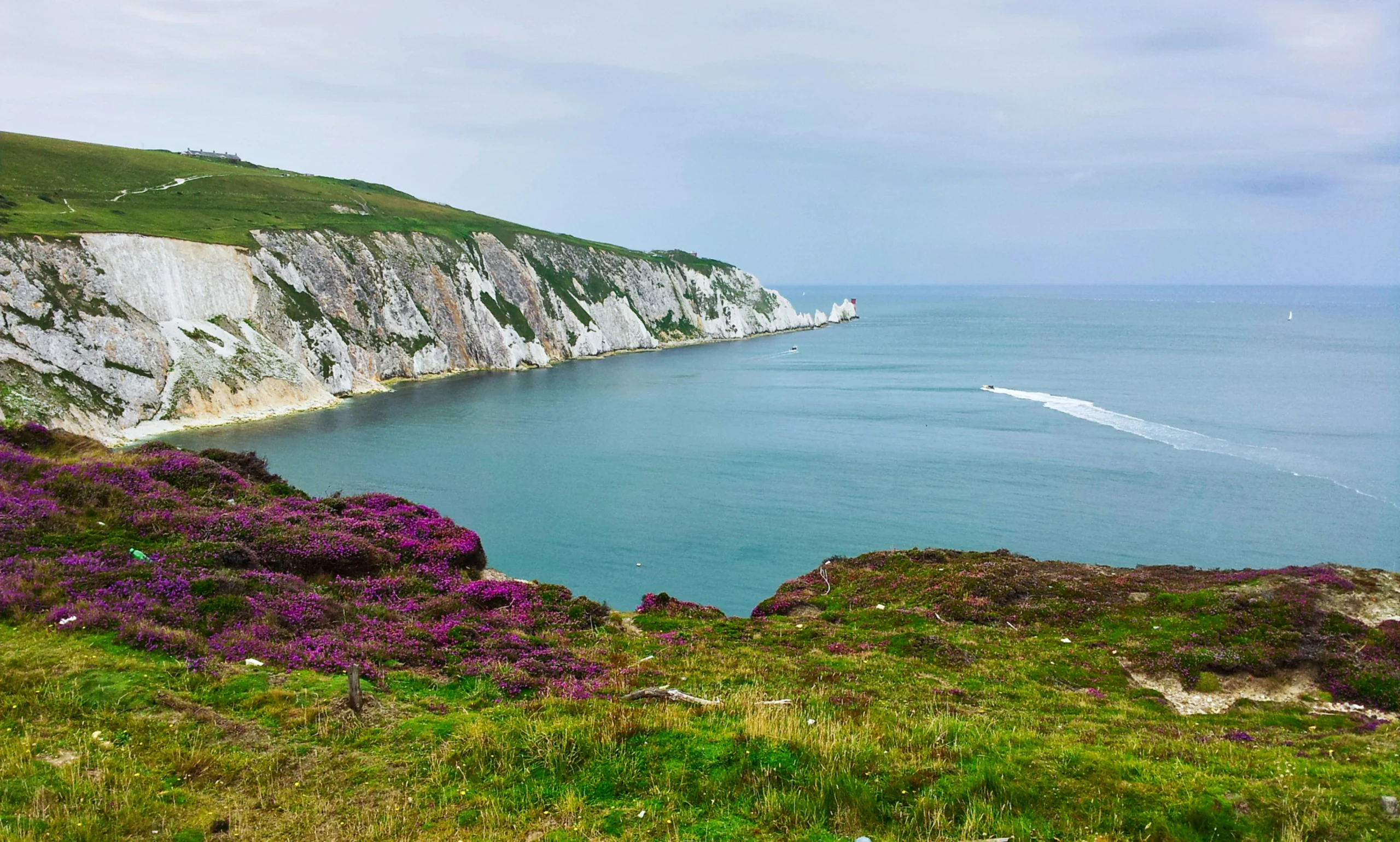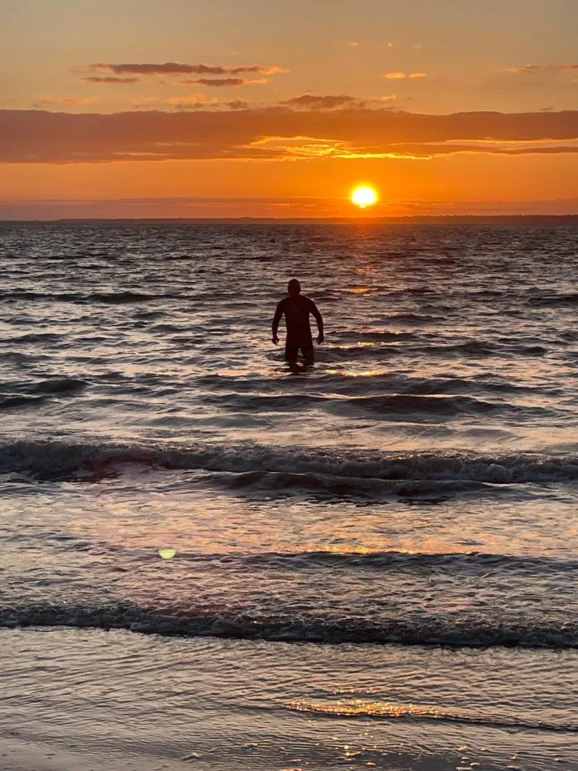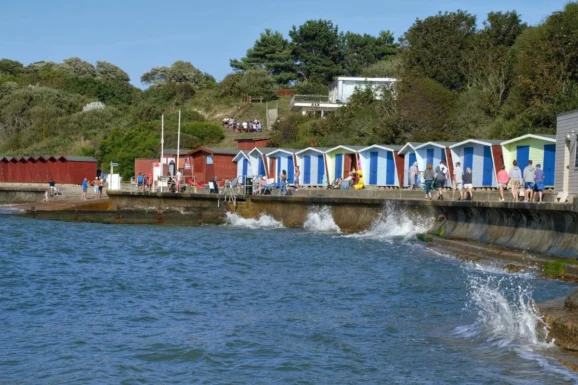Diving in to… The Isle of Wight

Ben Hooper
- Published
- Opinion & Analysis

In the second instalment of his Diving in to… series for The European, ultra-endurance swimmer Ben Hooper trades Berlin’s lakes for the bracing waters and coastal charm of the Isle of Wight. If you missed the first feature, you can read Ben’s guide to wild swimming in Berlin here
You wouldn’t expect what I assume to be one of the world’s most expensive ferry crossings to be just three nautical miles long, but that’s exactly what I paid: £280 return from Lymington to Yarmouth for a 45-minute crossing. It would almost have been cheaper – and certainly more rewarding – to swim.
Still, the windswept view from the deck made up for it. As we approached the sleepy Isle of Wight harbour, families, tourists, and, importantly, open water swimmers took in the fresh air and the promise of adventure. My mission was simple: to explore this chalky white island on foot, by car, and most importantly, in the water.
The Isle of Wight, shaped by rugged coasts and rich in Jurassic geology, offers a microcosm of British charm. From Neolithic ruins to pirate lore, royal retreats to tomato farms, fairgrounds to global music festivals, and of course, the world-renowned Cowes Week regatta – this island has long been a place of contrasts.
Yet it isn’t often thought of as a destination for wild swimming. That perception is changing, helped by the likes of endurance swimmer Oli Rush, who swam a record-breaking 96.6 km around the island in 15 hours, 19 minutes. Inspired – and, full disclosure, Oli is a friend – I set out to discover what the fuss was about.
Top Swim Spots on the Isle of Wight
From gentle family beaches to wild, surf-swept bays, the Isle of Wight offers a rich variety of wild swimming locations. Whether you’re after calm, sheltered waters or a bracing plunge in more challenging conditions, there’s a swim to suit every level. These are the standout spots – beautiful, rewarding, and best approached with local knowledge and caution.
Freshwater Bay
Framed by white cliffs and famed for its rugged beauty, Freshwater Bay offers an exhilarating, albeit challenging, swim. The pebble beach quickly shelves into deep, choppy water, with temperatures ranging from 10°C in spring to 21°C in high summer. Ideal for strong swimmers, this spot is not recommended for beginners. Early mornings here feel wild and remote, particularly around the collapsed cliff arch, visible at high tide. There’s limited shelter and strong currents beyond the cove, so always check conditions. Nearby facilities include kayak hire, a cliff walk up to Tennyson Monument, and the obligatory ice-cream hut.
Totland Bay
One of the calmest and most scenic swimming locations on the island. Shallow entry, flat waters and a west-facing view make this ideal for evening swims and romantic dips. With a sandy beach, a peaceful promenade, and proximity to cafés and Totland Pier, Totland Bay is accessible, family-friendly and perfect for all ability levels. I even swam past the local triathlon swim club on one visit.
Compton Bay
A wilder choice, with dramatic cliffs and expansive sandy shoreline. Popular with surfers, this beach suits only confident swimmers due to strong currents and the occasional riptide. Facilities are minimal, but the setting is magnificent, particularly at sunrise or sunset. Be mindful of tide times at Compton Bay and don’t swim too far out.
The Majestic Waterside Pool, Ryde
For those preferring structure and security, Ryde’s open-air lido is a fine alternative. Heated, lifeguarded, and perched above the Solent, it’s perfect for training or relaxed lengths. Entry starts at £6 for adults. While not ‘wild’, the sea breeze and passing ferries add atmosphere, and the pool offers accessible outdoor swimming without tidal concerns.
Shanklin Beach
A classic British seaside spot – busy in summer but safe, sandy and gently shelving. Lifeguards are present in high season, and facilities include arcades, beach huts and cafés. Shanklin Beach is enjoyed early morning or out of season for a peaceful experience.
Appley Beach, Ryde
Wide, shallow and relaxed, Appley Beach is popular with families. At mid to high tide, it’s ideal for easy swims and paddling. Appley Tower provides a fairytale backdrop, and local cafés and toilets add convenience. Great for shoreline swims with minimal risk.
Osborne Beach
Once Queen Victoria’s private beach, Osborne Beach’s quiet charm still lingers. Calm, sheltered waters make this spot a tranquil dip – and the royal bathing machine still rests on the shingle. Entry requires a ticket to Osborne House, but the experience of swimming where monarchs once bathed is quite something.
Lake Beach, Sandown
Nestled between Sandown and Shanklin, Lake Beach offers a quieter alternative to the larger resort towns. The beach is sandy, gently sloping and peaceful, ideal for floating or unhurried swimming.
Colwell Bay – Extreme Caution
Famous for its colourful huts and strong currents, Colwell Bay should never be swum alone. The annual organised swim event is properly marshalled for good reason: currents here can exceed 12 knots. An exhilarating challenge only for experienced swimmers with full support.

Places to Visit
Rich in history and natural beauty, the Isle of Wight is home to royal residences, ancient castles, botanical gardens and dramatic landmarks. These attractions offer the perfect way to round off a swim-filled day or to spend a dry one exploring by foot, bike or boat.
- Osborne House, East Cowes – Queen Victoria’s seaside home. Grand interiors, Italianate gardens and a private beach await.
- The Needles and Alum Bay – Iconic chalk stacks and multi-coloured cliffs. A boat trip or chairlift ride makes this a top coastal attraction.
- Carisbrooke Castle, near Newport – Norman stronghold where Charles I was held. Walk the battlements and meet the famous donkeys.
- Ventnor Botanic Garden – A subtropical haven thanks to a unique microclimate. Ideal for slow strolls and plant-lovers.
- Blackgang Chine – Quirky theme park with pirate coves, dinosaurs, and cliffside rides.
- Tapnell Farm Park – Animal encounters, play zones and zip wires for children (and weary parents).
- Isle of Wight Steam Railway, Havenstreet – Step back in time aboard a vintage steam train with museum and café.
Rainy Day Ideas:
Even in Britain’s sunniest spot, the weather can turn. Fortunately, the Isle of Wight is packed with engaging indoor attractions. From maritime museums and heritage railways to animal sanctuaries and storytelling exhibitions, these are excellent options when the skies open – or when you simply need a break from the water.
- The Classic Boat Museum (East Cowes & Cowes) – Split across two sites, filled with maritime heritage and model boats.
- Monkey Haven – Animal sanctuary near Newport. Great for families and indoors enough for bad weather.

Hidden Gems:
Beyond the well-trodden routes and tourist favourites lie some of the island’s most rewarding discoveries. These quiet corners and lesser-known landmarks offer space to breathe, reflect and enjoy the Isle of Wight’s unhurried charm. Ideal for curious travellers looking to escape the crowds.
- Mottistone Gardens & Estate – Quiet, winding paths, and wildflower meadows. A National Trust retreat off the main trail.
- Newtown Nature Reserve – Wetlands, woodlands, and the remains of a once-prosperous medieval town.
- Godshill Model Village – Delightful miniature village with intricate details – and a real one next door.
Where to Eat
Island life means fresh seafood, seasonal produce and more than a few surprises. Whether you’re after a fine dining experience, a beachside burger, or a cream tea in a thatched cottage, the Isle of Wight’s food scene caters to every appetite. Here are some of the best places to refuel after a swim.
- The Waterfront Bar & Restaurant (Totland Bay)
Casual beachside fare with unbeatable sunsets. £20–£30pp. Local ales: £5, wines: £6–£8. - The Duck (Ryde)
Seasonal fine dining. Confit duck, truffle fries and cocktails. £30–£45pp. - The Cow (Tapnell Farm)
Comfort food meets island produce. Burgers, fries and milkshakes. £15–£20pp. - The Boathouse (Seaview)
Elevated pub classics with sea views. Fish pie, calamari and sticky toffee pudding. £20–£30pp. - The Hut (Colwell Bay)
Casual beachside glamour. Lobster, burrata, truffle fries and cocktails. £35–£60pp. Book early. - Isle of Wight Tea Rooms (Godshill, Shanklin and more)
Floral china, jam-laden scones, and fragrant teas. Cream tea: £6–£10.
Picnics and Where to Enjoy Them
Sometimes the best meals come in a paper bag with a view. The island is made for picnicking – from cliff tops and gardens to secret coves and windswept ruins. With excellent local produce available and no shortage of stunning locations, here’s how and where to do it properly.
Where to Shop:
- Island Bakers (Newport) – Sourdough, focaccia and brownies.
- The Garlic Farm (Newchurch) – Chutneys, garlic mayo, aioli, and local produce.
Picnic Suggestions (Per Person):
- Sourdough sandwich with island ham and cheddar – £4.50
- Tomato salad with garlic chutney – £3.00
- Fruit tart – £2.50
- Isle of Wight cider or apple juice – £3–5
Total: £10–15
Top Picnic Spots:
- Tennyson Down – Clifftop drama and solitude.
- Newtown Creek – Estuarine calm and birdlife.
- Appuldurcombe Park – Ruins, lawns, and silence.
- Ventnor Botanic Garden – Mediterranean microclimate and views (entry fee).
Where to Stay
Whether you favour Victorian hotels, sea-view glamping or remote woodland camping, the Isle of Wight has a place to match your style of travel. These accommodation options range from the grand to the off-grid – all with the same warm island welcome.
- Luccombe Manor, Shanklin
Victorian charm, sea views, dog-friendly. From £90/night. - The Royal Hotel, Ventnor
Traditional luxury with afternoon tea. From £160/night. - The Albion, Freshwater Bay
Refurbished coastal retreat. Sea-facing rooms: £120–£180. - Tom’s Eco Pods, Tapnell Farm
Off-grid chic with alpacas and electric bikes. From £120/night. - Compton Farm, Compton Bay
Rugged coastal camping. From £15/night. - Camp Corve, Brighstone Forest
Sustainable woodland hideout. Pitches from £20/night. - The Garlic Farm Yurts
Gourmet glamping among garlic fields. From £130/night.
Ben’s Wild Water Swimming Tips
Open water swimming is deeply rewarding, but it demands care, preparation, and respect for the elements. These essential safety tips are drawn from experience – both mine and others’ – and are aimed at helping swimmers of all levels enjoy the water with confidence.
- Know Your Limits – Start with calm waters and short swims.
- Check Conditions – Temperature and current awareness is vital.
- Wear a Bright Swim Cap – Visibility is safety.
- Acclimatise Gradually – Avoid cold-shock.
- Watch for Boats and Wildlife – Stay alert.
- Swim with a Friend – Never swim alone. Be CPR-trained.
- Respect the Sea – Understand local conditions and don’t take unnecessary risks.

Ben Hooper hit the international headlines after revealing what has been described as one of the world’s most ambitious expeditions: to swim “every single mile” of the Atlantic Ocean – according to Sir Ranulph Fiennes OBE, the last great bastion to be conquered. Ben’s intended journey, across two-thousand miles of open ocean between Senegal and Brazil, would take up to 4-months, and would enter the record books. The expedition, called ‘Swim the Big Blue’, following Ben’s death from swimming into thousands of left-over Portuguese Man O’War tentacles and his incredible restart, mid-Atlantic, was eventually thwarted by adverse weather conditions damaging his support vessel. It was a devastating blow following years of painstaking dedication and training. Today, Ben holds the only WOWSA verified attempt to swim the full extent of The Atlantic Ocean.
Main image: Altaf Shah/Pexels
Sign up to The European Newsletter
RECENT ARTICLES
-
 The digital euro is coming — and Europe should be afraid of what comes with it
The digital euro is coming — and Europe should be afraid of what comes with it -
 Why Greece’s recovery depends on deeper EU economic integration
Why Greece’s recovery depends on deeper EU economic integration -
 Why social media bans won’t save our kids
Why social media bans won’t save our kids -
 This one digital glitch is pushing disabled people to breaking point
This one digital glitch is pushing disabled people to breaking point -
 Japan’s heavy metal-loving Prime Minister is redefining what power looks like
Japan’s heavy metal-loving Prime Minister is redefining what power looks like -
 Why every system fails without a moral baseline
Why every system fails without a moral baseline -
 The many lives of Professor Michael Atar
The many lives of Professor Michael Atar -
 Britain is finally having its nuclear moment - and it’s about time
Britain is finally having its nuclear moment - and it’s about time -
 Forget ‘quality time’ — this is what children will actually remember
Forget ‘quality time’ — this is what children will actually remember -
 Shelf-made men: why publishing still favours the well-connected
Shelf-made men: why publishing still favours the well-connected -
 European investors with $4tn AUM set their sights on disrupting America’s tech dominance
European investors with $4tn AUM set their sights on disrupting America’s tech dominance -
 Rachel Reeves’ budget was sold as 'fair' — but disabled people will pay the price
Rachel Reeves’ budget was sold as 'fair' — but disabled people will pay the price -
 Billionaires are seizing control of human lifespan...and no one is regulating them
Billionaires are seizing control of human lifespan...and no one is regulating them -
 Africa’s overlooked advantage — and the funding gap that’s holding it back
Africa’s overlooked advantage — and the funding gap that’s holding it back -
 Will the EU’s new policy slow down the flow of cheap Chinese parcels?
Will the EU’s new policy slow down the flow of cheap Chinese parcels? -
 Why trust in everyday organisations is collapsing — and what can fix it
Why trust in everyday organisations is collapsing — and what can fix it -
 In defence of a consumer-led economy
In defence of a consumer-led economy -
 Why the $5B Trump–BBC fallout is the reckoning the British media has been dodging
Why the $5B Trump–BBC fallout is the reckoning the British media has been dodging -
 WPSL Group unveils £1billion blueprint to build a global golf ‘super-group’
WPSL Group unveils £1billion blueprint to build a global golf ‘super-group’ -
 Facebook’s job ads ruling opens a new era of accountability for artificial intelligence
Facebook’s job ads ruling opens a new era of accountability for artificial intelligence -
 Robots can’t care — and believing they can will break our health system
Robots can’t care — and believing they can will break our health system -
 The politics of taxation — and the price we’ll pay for it
The politics of taxation — and the price we’ll pay for it -
 Italy’s nuclear return marks a victory for reason over fear
Italy’s nuclear return marks a victory for reason over fear -
 The Mamdani experiment: can socialism really work in New York?
The Mamdani experiment: can socialism really work in New York? -
 Drowning in silence: why celebrity inaction can cost lives
Drowning in silence: why celebrity inaction can cost lives



























